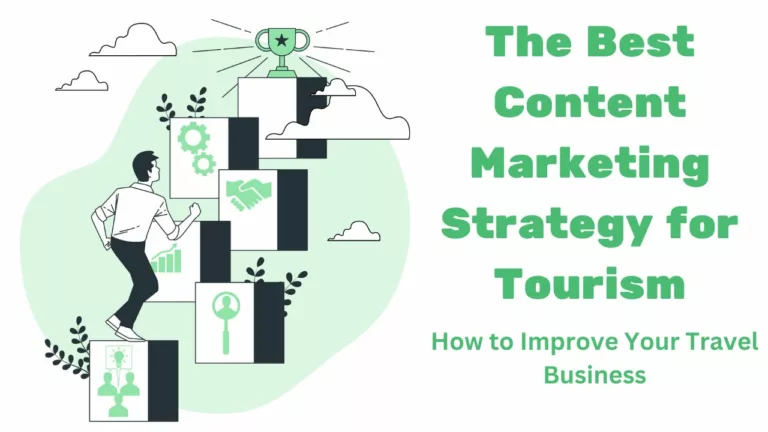

The Best Travel Content Marketing Strategy for Tourism
We all want to offer a service that exceeds our clients’ expectations. But, as a travel business, how do you create content that takes the reader and the search engines into account?
This may sound like a near-impossible task, but with the right strategy, the only limit is your imagination. As such, this guide will unpack everything you need to know to help you find the right formula for your travel agency.
From travel companies specialising in luxury vacation packages to local tour agencies offering bespoke experiences, everyone needs a solid marketing strategy. Whether you’re looking to write more blog posts or need help defining your goals, stick around to discover the ins and outs of the best tourism content marketing.
Top Tip: This post will greatly help you, but if you need expert help, we also offer a range of marketing services focused on driving traffic and revenue.
What Is Content Marketing for Travel and Tourism?
In short, content marketing is creating and sharing online content. When you look at it in terms of the tourism industry, this largely has to do with content that is associated with travel.
This can be anything from travel itineraries, and activity guides to staying safe in a particular destination and much more. This content is made to drive organic traffic to your website, thus spreading the reach of your company and brand.
Why Content Marketing Is Essential for the Travel Industry
Aside from resulting in more people visiting your website, what quantifies spending time and money on a content marketing strategy?
While PPC campaigns and paid ads are a surefire way to get traffic fast, it’s not sustainable. Ad campaigns cost a lot of money, and as soon as you stop, a lot of your traffic will quickly disappear.
This is where content marketing is so important, as it’s a natural way to add content to your page and gain traffic and clients. A content marketing strategy can also help you identify exactly what your target audience is looking for, which can further improve the results of your PPC campaigns.
You may have noticed that Google’s search engine is also looking for more personalised content, especially within the travel industry. This isn’t some random decision either, as around 81% of travellers prefer a tailored and personalised experience.
While your services may be personalised, is the content on your website? Does your website show the expert, first-hand experiences that make the user want to use your services? These are just a few questions that offer a quick glimpse into how important content marketing is for a travel business.
In other words, content marketing for travel companies isn’t going anywhere. Rather, it will get even more important as the need for quality, expert content is increased due to the rise of machine learning tools like ChatGPT.
Most Successful Types of Content for the Tourism Industry
Before we dig into the best content marketing strategy, let’s look at the different types of content you can create.
A Blog Post
Many a travel blogger uses this content type to great effect. Generally, blog posts target long-tail keywords that will be easy to rank for. The main thing to remember is that you need to create original, high-quality content that offers information your competitors don’t.
Blog posts are also a fantastic opportunity to internally link to your products or services, helping drive traffic towards your money-making pages. The goal of a blog post is to match the search intent, ensuring that potential customers are left with a satisfactory answer.
Top Tip: If you want to improve your content, we offer a range of content-writing services for every budget.
User Generated Content
User-generated content (UGC) is fast becoming an important ranking factor for search engines. UGC is content created by customers through reviews of your website, testimonials, or sharing of your content via social media.
This helps show user engagement with your content, which emphasises your brand’s legitimacy and trustworthiness. This is one of the harder forms of content to attain, but a good marketing strategy can help drive such content towards your website.
Email Newsletters
No, newsletters aren’t out of fashion. They’re still one of the most powerful tools in a travel marketer’s arsenal. Email newsletters help you stay in touch with existing customers, ensuring your company is always at the back of their minds when planning their next big trip.
From informing them of personalised offers to notifying them of your latest blog posts with essential travel information, a powerful newsletter can make all the difference.
Social Media Posts
A consistent social media presence is one of the best ways to build brand awareness. Not only does it spread your marketing wings to new customers, but it also helps build credibility for your company.
Social media allows your travel business to connect with customers in new ways and provides the opportunity to engage in their interests. Bear in mind that social media copy is very different from website copy, but you can still use this step-by-step guide towards content creation.
Videos
Last but certainly not least, we have videos taking the internet by storm. Aside from the traditional marketing practice of written content, video content allows you to showcase a more personalised experience.
Just to show how important videos have become in today’s day and age, here are some undeniable stats.
On average, having video content on your web pages increases organic traffic by 157% and improves the time spent on a website by 105%. If that’s not enough proof of video importance, a massive 84% of people are convinced to purchase a product or service after watching a brand’s video on a product.
In other words, it’s about time that video commissions become a part of your content marketing strategy, and fast.
How to Create a Successful Content Strategy for Your Travel Business
It’s time to dive into how you can create a content marketing strategy that will see you get the best results possible.
1. Create an Audience Persona for Your Target Market
Defining your target audience will help you determine the people searching for your type of products/service. A user persona is essentially a profile of your ideal customer.
Using customer and market research, you can quickly determine key points, such as customer demographics and the ideal type of traveller. This is extremely important, as it ensures you offer personalised content that makes the reader feel you’re talking directly to them.
Here are a few essential questions you can use to create your audience persona:
- Who are your customers?
- What are the demographics of your ideal customer?
- Where are they from, and where are they travelling?
- What are their pain points or problems that need resolving?
- What are their main goals?
- What is the ideal purchasing process of your ideal customer?
Write your ideal answers to these questions, and then use these points to gather customer data. After analysing the data, you’ll quickly understand your target audience.
Top Tip: If you need more help, here’s our guide to building your own tourism marketing plan.
2. Define Your Travel Brand Identity
Before looking for topics to write about, you’ll need to define your brand identity. This is a crucial step, as it ensures you only find content ideas relevant to your company.
Here are a few points to keep in mind when establishing your brand identity:
- What are your targeted travel destinations?
- What is the tone and voice of your writing?
- What type of content do you usually produce? For example, is it blog posts or video content?
- What are your company’s key goals within the travel industry?
- What makes your brand unique? Ensure the content you produce doesn’t affect this unique quality.
With your brand identity and audience persona in hand, you’ll have a fairly good idea of the content you need to target.
3. Do Keyword Research to Identify Topics to Target
The next step is doing some travel-related keyword research to help you find new topics to produce content around. The goal of keyword research is to find easy topics you can make content on to get as high as possible in the search engine rankings.
You can use a few free tools to help with this process, such as the Keyword Surfer Extension or the SEOquake Extension. While these tools are great, the paid tools on Ahrefs and Semrush are far more comprehensive, providing better data.
Top Tip: If you need help finding new topics, here is our affordable topic-mining service to provide you with the best possible results.
4. Create a Content Calendar to Follow
Once you have a comprehensive list of new topics, it’s time to start formulating a content calendar. This will help ensure you produce new content throughout the year rather than dumping a huge amount of content all in one go.
In SEO, consistency is key. If you can stagger your content across the months strategically, you’ll help show Google you are constantly looking to improve your website and offerings.
When creating your content calendar, align your topics to fall within the optimum time to post.
For example, writing a piece on the “Best places to visit in Italy in Spring” may be best to write and post the topic in Winter. This way, your content will go live when people are looking to plan a trip to Italy.
5. Start Creating Content for Your Target Audience
Now, it’s time to start creating your own content. When producing your content, be sure to look at the top-performing competitor pieces to get a good idea of what your audience is looking for.
Don’t copy their content outright, but cover a similar range of information. To take things one step further, add more, make your content unique, and provide more essential information that your competitors may be missing.
This is an excellent blueprint for producing highly successful content, whether that’s videos, social media posts, or blog posts.
Top Tip: If you need help producing quality content, our range of writing services is at your disposal.
6. Track the Performance and Improve the Strategy
Lastly, and possibly the most important aspect of a successful content marketing strategy, is to track your content performance. Any good SEO strategy has to continuously adapt to Google changes. So, while a content strategy may have worked a year ago, that doesn’t mean it will be successful again.
By continuously tracking your content performance, you can understand what works and what doesn’t. It also helps you get a good sense of what content may be worth optimising.
Top Tip: If you want a holistic understanding of your website, we offer a range of SEO audits to help you get the most out of your website.
How to Maintain Your Strategy and Get the Best Results
Producing amazing travel content is one thing, but ensuring it continues to perform well is another thing. Here are some tips you can use to ensure you get the best results.
Promote Your Content on Your Social Channels
Promoting new content is a fantastic tool travel marketers can use to increase their reach. From your company’s Facebook page to your personal Instagram account, use these platforms to promote fresh content.
You’ll be surprised how much new traffic you can get to your website with a consistent social media presence.
Top Tip: If you need help with your social media presence, we have a range of social media offers for you to utilise.
Turn Organic Traffic Into New Clients
Make the most of your new content by turning new traffic into clients. The easiest way to do this is by incorporating internal links to your products or services within the content. Be mindful that you will still want to do this naturally.
Ensure Your Content Is Up-To-Date
If your content is out-of-date, it’s highly likely Google will drop your content lower down in the search results. To keep ahead of the competition, it’s best to optimise your content at least once a year, ensuring prices, dates, and any other essential information is accurate.
Top Tip: To get the most out of your content, we offer an optimisation service to improve every aspect of your piece.
FAQs About Content Marketing Ideas for Travel
Before sending you on your way, here are some quick answers to the most popular questions about content marketing for travel.
What Are the Four Pillars of Content Marketing?
The four pillars of content marketing are context, channel, connections, and commerce. Each pillar provides the following:
- Context — Provide context of your brand and the content you produce.
- Channel — Have channels to share content.
- Connections — Create connections with prospective clients.
- Commerce — Promote and support sales of your product or service.
What Are the Five Ps of Tourism Marketing?
The five Ps are fairly straightforward aspects of marketing that can help your business thrive. They are people, promotion, price, place, and product. Take these into account when producing content and offering services/products.
What Type of Content Is Best for Travel Businesses?
While each content type has pros, user-generated content is easily the most influential. It’s also the most difficult to get and usually requires one of the other content types to be made first.
If you can get user-generated content on your website or social media platforms, your business will massively benefit from it.
The Ultimate Guide to Tourism Content Marketing Wrapped Up
And just like that, you have a complete guide to creating a successful content marketing strategy for your travel business. Tourism is such a competitive industry, so getting ahead of the pack is huge.
So, get the chalkboard out and start planning a prosperous future for you and your business.
Next Read: If you’re a new startup, read our case study on a travel marketing strategy that saw 9000% growth after joining our team.

















